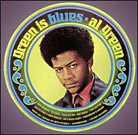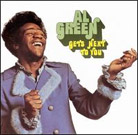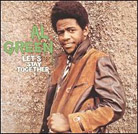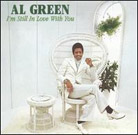April 2003
Mitchell liked what he heard and suggested that Green come back to Memphis with him. "You can be a star," Mitchell told him. The singer wondered how long it would take his new acquaintance to make good on that promise, and Mitchell told him, "Probably a year and a half." Green balked -- he didn’t want to wait that long -- but Mitchell eventually convinced him (with the help of a loan to settle some debts) and six weeks later Green was in a Memphis recording studio. The story of how Green met Mitchell and made his way to Memphis differs in small details, depending on who tells it, but they all agree about one thing: Together, Al Green and Willie Mitchell revitalized Southern soul music, made some of the best records of the '70s, and achieved the success they had been longing for. These reissues of Green’s first four titles on Hi Records show how the pair developed a unique sound that combined the grit of Southern soul with a smooth sophistication that both called "a jazz feel." They didn’t hit pay dirt first time out, but Green Is Blues is a solid effort that hints at the greatness that would soon show itself. On the first two tracks, "One Woman" and "Talk to Me," Green relies too much on his influences, particularly on Jerry Butler’s urbane cool. On the third tune, a cover of the Temptations’ "My Girl," he begins to find his own voice. The moments of quiet passion that soon distinguished him from other soul singers make their first appearance there, and that was the side of Green that Mitchell was trying to push ("Al, look, we got to soften you up some."). Hi Records’ first single by Green was a cover of "I Want to Hold Your Hand," one of four bonus tracks on Green Is Blues. Green’s easy slide into falsetto on that track is another foretaste of things to come, but neither it nor its follow up went anywhere. In late 1970 -- fulfilling Willie Mitchell’s prophecy -- Al Green had his first hit with his new label, and an unlikely one, at that. "I Can’t Get Next To You" had gone to #1 just one year earlier for the Temptations and, in truth, it’s a tune they’ll always own. But Green comes close to taking it away from them. It opens Al Green Gets Next to You, which contains the song that would be the blueprint for Al Green’s chart domination for the next few years. "Tired of Being Alone" was what Green and Mitchell had been working towards since they started recording. Green wrote the song and it opens with a chord change that has the jazz feel he and his producer liked. Alongside those changes are the hallmarks of Memphis soul -- a fat bass line, a hard, sharp snare drum, the low pulse of the kick drum, and a short, punchy horn arrangement. Over this mix of elegance and funk, Green combines the raw emotion of Otis Redding with the suave ease of Sam Cooke. One minute and 45 seconds into the song, he and Mitchell create a moment of transcendence. Green sings, "Sometimes I wonder," and the rhythm section pulls down low. The background voices come forward, and Tennie Hodges continues the chord progression with a series of exquisite arpeggios, throwing in a few fills here and there. Green pleads, but his plea is quiet, and when he reaches for high note to sing "Pl-e-e-e-se" it’s almost a whisper. In that moment, Al Green ceased being a contender and took his place with the greatest soul singers. Green wanted his next single to be something funkier, but Mitchell preferred "Let’s Stay Together, " a song he and Green had written with Al Jackson, the great drummer from Booker T. and the MGs. It went to #1 on the pop and R&B charts, the first of 12 top tens Green would place on the charts in the next five years. Each one of them followed the approach Mitchell mapped out for "I’m So Tired of Being Alone," an approach he described to Green as, "…silky on top, rough on the bottom." The Hi Records house band had more finesse than the word "rough" suggests. Guitarist Teenie Hodges’ sweet tone on rhythm guitar and the beauty of his refined, unobtrusive accents play an enormous role in establishing the feel of these records. He was joined by his two brothers, Charles, whose Hammond organ gave the sessions their gospel underpinning, and Leroy, whose solid, musical bass lines provide the fat bottom end that Mitchell wanted. The rock-solid foundation was provided by drummers Al Jackson and Howard Grimes. A striking characteristic of Mitchell’s productions is his drum sound. The snare rings out sharply; it's the center that holds everything together. With that band at the core, Mitchell added string arrangements and horns (the Memphis Horns, who, like Al Jackson, played on so many Stax/Volt recordings). These additions sweetened the sound without compromising its emotional punch. Mitchell’s genius was to inject some uptown Chicago suaveness into Southern soul’s blues and gospel core and remain true to them both. And, while it’s true that he was the architect of these recordings, he was no Svengali -- Green wrote or co-wrote all of his hits. Once Mitchell convinced him of the success of his methods, Green worked as hard as he did to bring their sound to life. The remastering by Bob Norberg remains true to that sound. The discs are clean and smooth and retain much of the analog warmth of the LPs. Although Mitchell and Green had their sights set on making hits, these albums are remarkably consistent. They contain songs that are so well known, they might as well have been hits, such as "Love and Happiness" from I’m Still In Love With You or "Old Time Lovin'" from Let’s Stay Together. The only thing close to a dud on these discs is a slightly overlong version of "For the Good Times." The Love Songs Collection takes in almost all of Green’s hits, plus a few other gems, and it’s a good place to start. But it can only scratch the surface because everything on these albums -- everything on every album Al Green and Willie Mitchell made together -- is essential. GO BACK TO: |
 Al Green - Green is Blues
Al Green - Green is Blues Al Green - Gets Next to
You
Al Green - Gets Next to
You Al Green - Let's Stay
Together
Al Green - Let's Stay
Together Al Green - I'm Still in
Love with You
Al Green - I'm Still in
Love with You Al Green - The Love Songs Collection
Al Green - The Love Songs Collection Willie Mitchell was a
producer, arranger, and recording artist for Hi Records in Memphis when, in 1968, he heard
Al Green for the first time. Mitchell was touring in support of his hit single, "Soul
Serenade," and was playing a club in Midland, Texas that had booked Green as the
opening act. Green, then known as Al Greene, had scored a hit for Bell Records with
"Backup Train." He was rehearsing with Mitchell’s band and began going over
the changes for his hit song.
Willie Mitchell was a
producer, arranger, and recording artist for Hi Records in Memphis when, in 1968, he heard
Al Green for the first time. Mitchell was touring in support of his hit single, "Soul
Serenade," and was playing a club in Midland, Texas that had booked Green as the
opening act. Green, then known as Al Greene, had scored a hit for Bell Records with
"Backup Train." He was rehearsing with Mitchell’s band and began going over
the changes for his hit song.